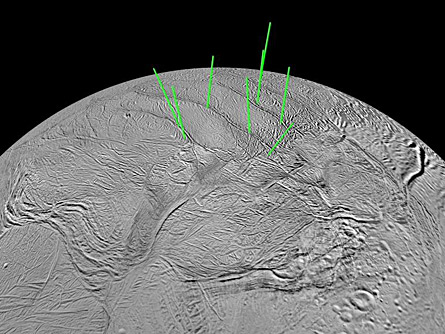Swooping within 25 kilometers of Enceladus, the Cassini spacecraft has obtained additional evidence that the interior of this tiny, icy moon of Saturn may contain liquid water. Hunter Waite of the Southwest Research Institute in San Antonio and his colleagues base their findings on close-up observations made with Cassini’s Ion and Neutral Mass Spectrometer, which on March 12, 2008 and October 9, 2008 tasted the plumes of icy particles and water vapor known to spew from the moon.

In a research abstract for a talk that was scheduled to have been given May 27 in Toronto at the 2009 Joint Assembly of the American Geophysical Union, Waite and his collaborators cite two findings that they say “provide compelling evidence for the existence — today or in the recent past — of liquid water in Enceladus’ interior.” The abstract has been publicly available for weeks with no embargo.
One finding is that the plume contains ammonia, which readily dissolves in water and acts to keep liquid water at lower temperatures than would otherwise be possible in the moon. The other finding is the probable detection of argon-40, which might have been transported to the plume by liquid water coursing through minerals inside Enceladus.
Waite declined to elaborate on the findings, noting that his team had submitted an article on the topic to Nature and did not want to jeopardize the submission. Waite has since said that his team has withdrawn the abstract because of the Nature submission, and the talk was not given at the meeting. However, at press time the abstract remained on the meeting website. A spokesman for the American Geophysical Union in Washington, D.C., which organized the meeting, confirmed that the abstracts may be cited by reporters as soon as the material is posted online and are not embargoed until a presentation is given.
Researchers have speculated about the possibility of liquid water within Enceladus since 2005, when the Cassini spacecraft discovered a geyser of ice particles and vapor emanating from cracks in the moon’s south pole. The possibility of liquid water inside the moon, along with a variety of organic compounds found in the plume, suggest Enceladus may now or in the recent past have had the right stuff to support life.
“The high solubility of ammonia in liquid water is consistent with an ammonia-water solution as the source of the plume,” commented theorist Andy Ingersoll of the California Institute of Technology in Pasadena. “So the presence of ammonia does point to liquid,” he added. Ingersoll’s comments were provided several days before Waite’s team withdrew the abstract.
Ingersoll also noted that argon-40 is typically produced by the radioactive decay of potassium-40. The argon produced in this manner would be trapped in the mineral that contained the potassium, he said. One way of removing the argon from inside Enceladus and transporting it into the plume “involves passing a liquid, usually water, through and around the mineral,” he noted.
According to the abstract, Waite and his collaborators for the first time measured the ratio of two atoms — hydrogen and its less abundant isotope deuterium, which has twice hydrogen’s mass — in the plume material. The ratio recorded by Cassini could provide a clue to Enceladus’ origin. For example, the ratio of deuterium to hydrogen in comets is known to be much higher than those among Earth and other terrestrial planets. A high ratio would therefore indicate that Enceladus coalesced from cometary material, which is thought to have formed between the orbits of Uranus and Neptune, much farther from the sun than Saturn lies. Waite’s team has previously reported that gases in Enceladus’ plume have a composition remarkably similar to comets.







